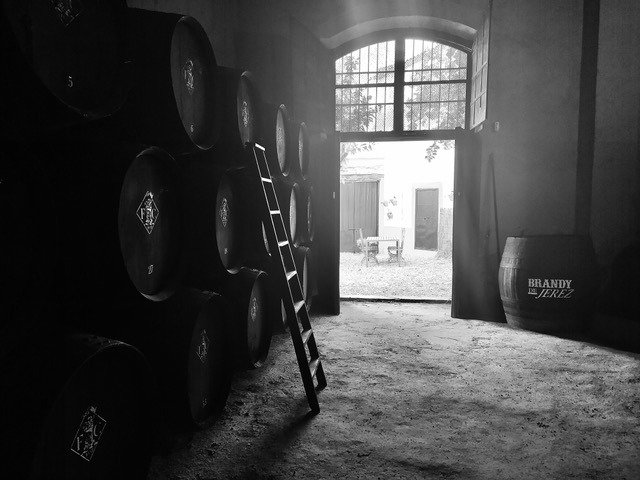
Bodega Fernando de Castilla. Photo © Karethe Linaae
A bodeguero is a person who owns and runs a wine bodega. Other than bull fighters, you probably won’t find a more typical Spanish profession. Yet to some people’s surprise, there is a genuine Norwegian bodeguero right in the middle of the golden triangle of sherry production, in the old town of Jerez de la Frontera.
Jan Pettersen (64) is the man behind the reputed Bodega Rey Fernando de Castilla. His sherry house is now the 8th biggest wine- and liquor exporter in the entire Cádiz province. In fact, a couple of days after I went to interview him, the Bodega was due to host the closing party for Copa de Jerez, an event that attracts some of the best restauranteurs and largest wine personalities in the world! So, we are not talking granny-sherry and cheap brandy.
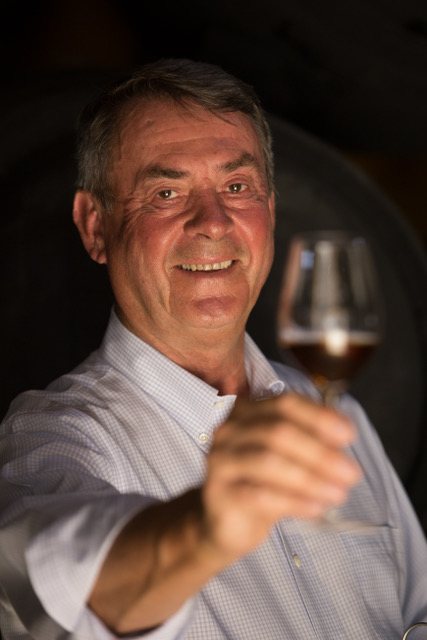
Jan Pettersen, bodeguero. Photo © Bodega Fernando de Castilla
His own sherry-house
Jan came from Norway to Barcelona exactly 40 years ago to undertake an MBA. On gradation in 1983 he was hired by Osborne (which at the time was the largest wine and liquor company in Spain) and became responsible for their Scandinavian market. Sixteen years later he was responsible for the Corporation’s international subsidiaries and distribution companies.
But how did you end up as the bodeguero for Fernando de Castilla?
“In 1999 Osborne wanted to reorganize the business and amongst others stop producing sherry. I had become a sherry romantic in my years with the company and thought that it was rather tragic that they would abandon such traditional productions. I tried without luck to buy their affiliated company that dealt with sherry and port wine. The business is so small here that everybody knows everybody, and soon it was known that I was looking to start on my own. And when I got the opportunity to buy this bodega in 1999, I didn’t hesitate”.
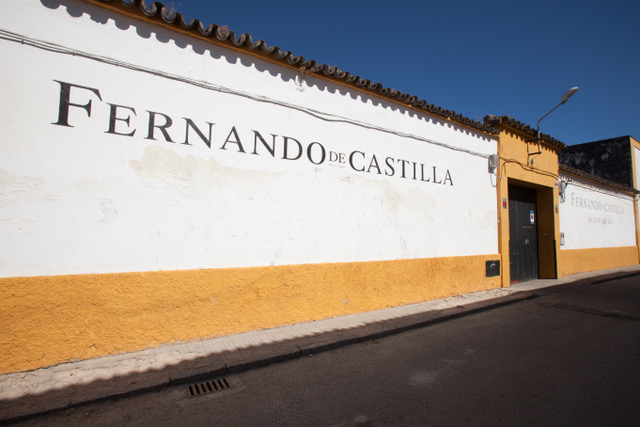
On a narrow street in old town Jerez. Photo © Bodega Fernando de Castilla
When Jan took over the business, Fernando de Castilla was a small company with a very limited product line and market. He also acquired another smaller adjacent bodega, so that today’s company is a fusion of these two old sherry houses. “I got new people in and converted much of the production process and administration, so we went from selling less than 30.000 bottles a year, to currently selling more than 500.000 bottles annually”.
Bodegas Rey Fernando de Castilla is now one of the 10 largest producers in the sherry industry. Jan sits on the Board of Jerez’ official industry association that determines who gets the seal of origin, or D.O. (Denominación de Orígen). “The bodega has gone from selling almost exclusively within Spain, to exporting approximately 90% of production to more than 50 countries around the world”.
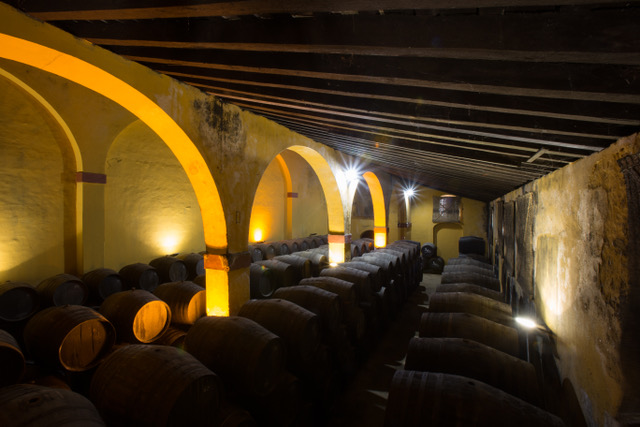
Bodega. Photo © Bodega Fernando de Castilla
Norway as well?
“Absolutely. Norwegians are very fond of brandy, so we sell a lot of that, while Norway is a bit behind the trend in the sherry market, due to prohibited advertising and limitations on marketing etc. The country also has only 5 million people and charges enormous taxes and duties, so I have never prioritised targeting the Norwegian Wine Monopoly. Our biggest export areas are the UK, USA, Germany, the Baltic and Scandinavia, but we also sell a lot to China and Australia”.
Almost a native
How do the people of Jerez accept a Norwegian sherry-bodeguero?
«It is quite strange, but I am so well integrated that people do not look at me as a foreigner anymore. Not at all! A while back the Chamber of Commerce asked me to give a speech about how it is to be a foreign businessman here in Jerez, but I had no comparison as I have only worked here. Maybe historically foreigners kept apart, but at present I am the only non-Spaniard on the board of the trade association. My wife is Spanish, our children were born and raised here and many of their friends come from the known Spanish sherry families. Perhaps I have brought some of the values, manners, seriousness from my native country, but otherwise I am practically a jerezano.»

Jan Pettersen outside Bodega Fernando de Castilla. Photo © Karethe Linaae
How would you describe Jerez as a town?
«Jerez has kept its uniqueness and is a place with a genuine atmosphere, compared to other Andalucian cities. It is a bit like Bergen in Norway- a town that has existed forever, with the same families, the same dialect, and the same way of life. It is a traditional town where people are a bit ‘tweed’ and old fashioned. Jerez was very international in the past, when the largest sherry families came from the UK and France. Many locals still have English surnames like Gordon, McKenzie and Garvey, or from the French sherry-families - Lustau and Domecq. Our PR Director is from the Domecq-family. My cellar master, Pepe Jerez, whom I inherited from the former owner, started working here when he was 14 and has been here now for 45 years. His uncle was cellar master before him, and now his son works with us, so when Pepe retires, we will have a third generation cellar master at the bodega.»

Old destiller in Bodega Fernando de Castilla. Photo © Karethe Linaae
Both timeless and trendy
«The Jerez-area has 3000 years of wine history. King Fernando de Castilla, whom the bodega is named after, reconquered Western Andalucía from the Moors, established the protectorate Jerez in 1264, and restarted wine production in the area. Sherry was for a long time the most important international wine. About 100 years ago 10% of all Spanish export income came from sherry – almost the same percentage as the income the tourist industry gives the country today! Although sherry is far from being in the same position now, Jerez sherry is the third most exported wine in Spain after Rioja and Cava. Under the seal of origin D.O. Vino de Jerez and D.O. Vinagre de Jerez (sherry vinegar), we produce 140 million bottles a year. And if you include other wine and liquor products, we are talking nearly 500 million bottles. Per year! Since the sherry golden triangle only has about 25 relevant bodegas with significant exports, production is very concentrated.»
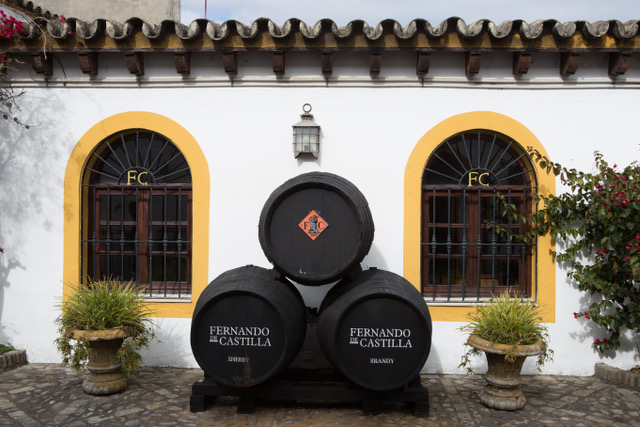
Courtyard. Photo © Bodega Fernando de Castilla
What makes sherry so special to you?
«There is nothing else that tastes like sherry. If you develop an appreciation for it, you will find that there is no substitute. 20 years ago, I had a feeling that if I didn’t do something with this unique product, it would become insignificant. I was fascinated by its history and saw the possibility to recreate the market, and to teach foreigners that quality sherry is one of the most interesting gastronomic wines that exist.
With sherry there are two worlds. First, there are the semi-sweet sherry types, like Pale Cream and Medium Dry, which are made for the English and the Northern European markets and which the Spanish never drink. And then there are the genuine sherries – Manzanilla, Fino, Amontillado and Orloroso, which are dry wines, as well as the sweet Pedro Ximenez. Sherry combines brilliantly with food. For example, Fino with fish and seafood, pata negra ham, sushi, smoked salmon and gravlax, and Amontillado with wild mushrooms and game.
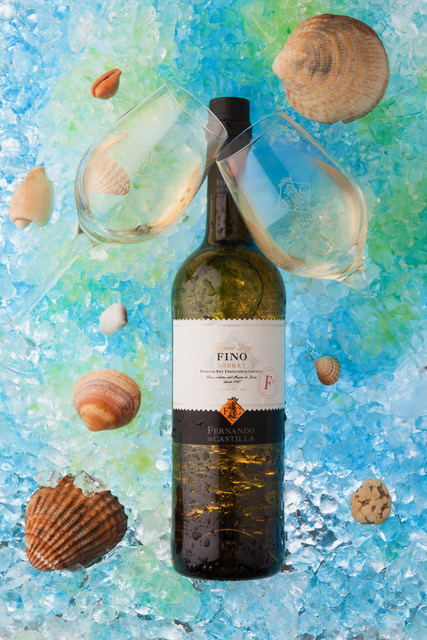
Fino. Photo © Bodega Fernando de Castilla
Premium sherry is today incredible trendy, and the market has simply exploded. Our sales are 40% up over 2020, which was a most difficult year due to the pandemic, but not that bad for our industry. If you compare it with Rioja and Cava, where sales went down perhaps 30–40%, the sherry industry only dropped 8% in 2020. And this year (2021) our numbers are already almost 30% better than 2019. We do not have enough product for sale to meet the demand.»
Premium, en rama and brandy
Bodega Fernando de Castilla is partnered with a Jerez family with a 43-hectare vineyard. Here the grapes are planted, harvested, and pressed. The juice is fermented and made into a base wine, which is kept in a barrel - sobre table – for a full year before it is brought to the bodega for the special soleras ageing process.
«We make 17 different sherries, all in the Premium and Super Premium categories. In our Antique-series the grapes are picked en rama (with stem) and are only filtered through a simple paper filter before being bottled. We were one of the first bodegas to do this, but now it has become trendy, and many have copied us. We were also the first to sell sherry in clear bottles. It was quite revolutionary 20 years ago, but to actually see the wine gives much more information about it.»
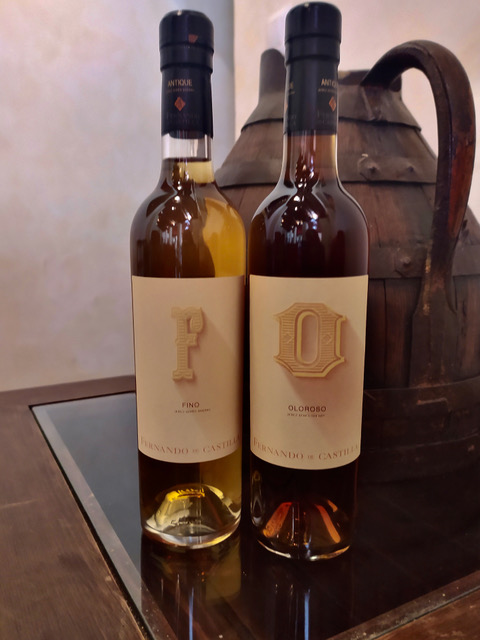
Antigue Fino and Oloroso. Photo © Karethe Linaae
What is the difference between a regular brandy and a sherry-brandy?
«Brandy has a much shorter tradition here than sherry, and only started as a commercial product some 150 years ago. Our bodega has never done anything with the cheap brandies - which is a large industry but is usually only sugar spirits with essence and colour. For our brandies we use the grape Airen, since completely neutral grapes won’t give an interesting distilled spirit. The distilling process leads to a very aromatic grape spirit with 63 % alcohol. Next, we bring the alcohol percentage down to just over 40%, transfer it into new oak casks for 1–3 years, and then over into used sherry casks. What makes brandy from Jerez so special is that we use the same soleras or fractional blending systems as the sherries, as well as that the brandy is stored in old barrels that used to contain sherry. This is compulsory for both the sherry and the brandy from Jerez to receive their D.O. accreditation. We never empty a barrel completely but only extract a maximum 1/3 of the oldest brandy or sherry, and then fill it up with the second oldest batch. After a while, one gets very many vintages in the system. I have soleras that have continued for over 100 years. The fractional blending system gives an increasingly interesting product over time, as every vintage that has been present has put its mark on the product. For this reason, either a sherry or brandy that has been maturing for 15 years in a soleras system is much more interesting than a product that has been laying stagnant in the same barrel for 15 years.»
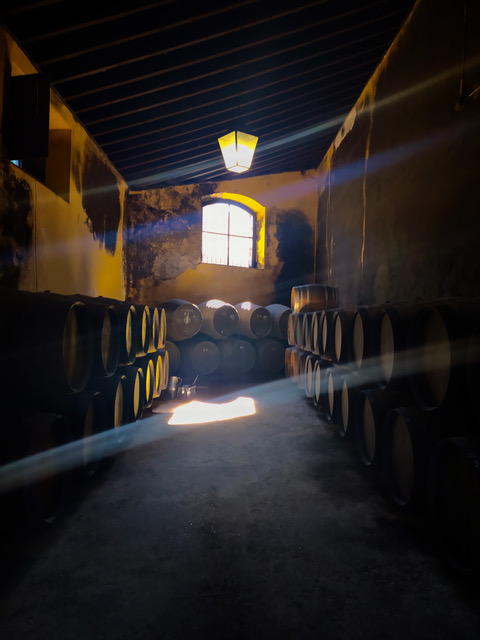
Classic bodega style. Photo © Karethe Linaae
What would you say is your contribution to the sherry industry in Jerez?
«While the demand for cheap sherry has dropped significantly, the sale of quality sherry has hit the roof. Some people claim that we have been lucky to be able to ride this wave of popularity, but I always say that we were one of the most important promoters to restart the sherry market. We worked with some of the world’s best wine companies and sommeliers to produce, and to teach people about quality. A whole group of new players came into in the industry later, who have seen that quality sherry at the right price is good business. We have taught others that it is possible to sell a quality sherry for 40 € for ½ a litre, even though some of the most known brands can cost as little as 5 € per bottle. So I will say that we have contributed to improving the quality of sherry.»

Antique sherry selection. Photo © Bodega Fernando de Castilla
Top 20 of 4000 wines
Two weeks before my visit, one of the bodega's oldest Pedro Ximenez sherries was selected for inclusion in Spain’s 20 best wines by Salon de Gourmet in Madrid. This was after the tasting-panel did a blind tasting of over 4000 contestants. The trophy stands amongst a row of other awards in the bodega’s wine bistro where our conversation takes place.
Is there a wine that you haven’t tried producing yet that you still would like to make?
«It would have to be a non-fortified white wine from the Palomino grape. Our clients have asked for this, so I probably ought to have such a product. Some years ago, we started with a new sherry-based vermouth which has been a major success. It is especially popular with people in Northern Spain who love to sit outside with a vermouth on ice with an orange peel twist. We kept at it for a long time trying to get the process and the botanical ingredients right. Everything I do must be top notch, and every time one tries something new, one puts one’s reputation on the line. So perhaps I ought to have a look at that white wine, but I am starting to get too old… »
And finally, if you had not ended up as a bodeguero, what would you have done?
«I have asked myself that many times. God knows! I have always enjoyed being creative. I enjoy buying and selling, so I probably have a bit of a pedlar-instinct. I get a kick out of making a deal with a company in some other part of the world, as well as launching a new product or trying a new method. So, I would probably have ended up doing something similar,” concludes the passionate Norwegian bodeguero.

Jan Pettersen, bodeguero. Photo © Bodega Fernando de Castilla
For more information: www.fernandodecastilla.es
Contact: bodegas@fernandodecastilla.com